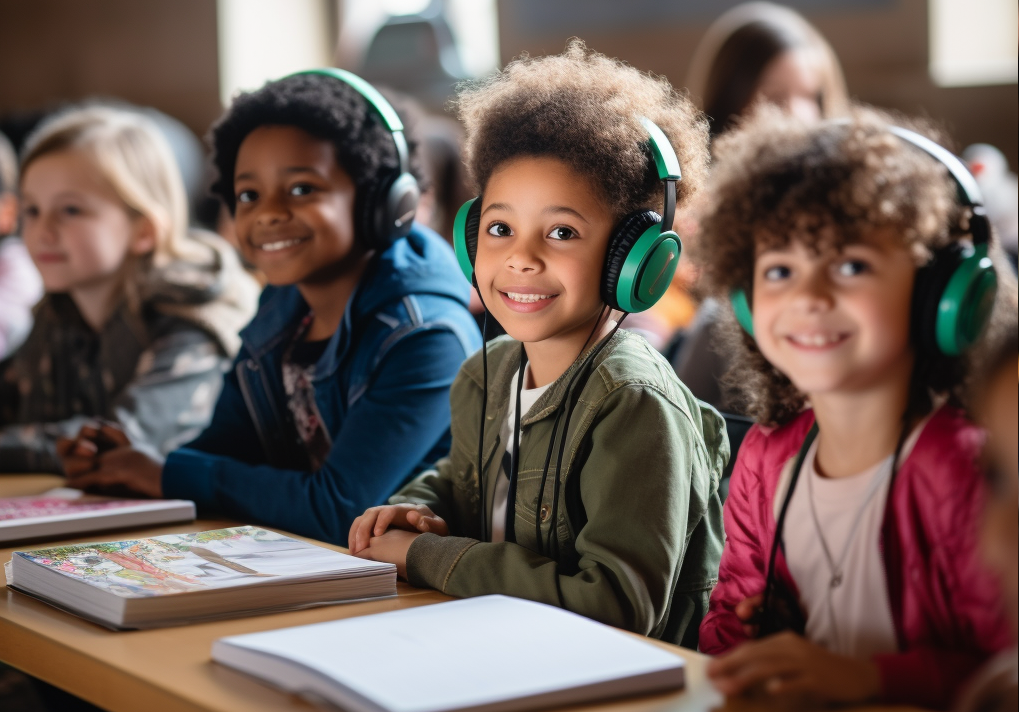Sonic Insights: The Case For Enriching Educational Catalogues with Audiobooks
In an era defined by innovation and evolving learning methodologies, publishers find themselves at a crossroads of opportunity. The traditional printed word, while timeless in its essence, is now joined by an increasingly popular, digital counterpart that taps into the human capacity for auditory engagement—audiobooks. As publishers navigate the ever-changing landscape of education, it's time to explore why audiobooks should secure their place in the heart of educational catalogues.

Educational publishers have long served as custodians of knowledge, preserving and disseminating information through the venerable print medium, and in recent years, through the sale and rental of digital textbooks. But as the world tilts towards technology-driven pedagogy, the question arises: Can't we do more than simply place a print replica on the screen?
Consider audiobooks, a form of content delivery that marries the sophistication of the written word with the immersive power of sound as an important part of your educational catalogue. By embracing this popular medium, publishers can invigorate their educational catalogues and cater to the diverse learning styles of a new generation.
It's not just a matter of convenience; it's about equity and diversity in the way subjects are taught, and increasing learning in the entire student population, regardless of their physical or social situations.
While there may be a bias toward the written word in education circles, research demonstrates that, although different parts of the brain are activated when listening to an audiobook, the human brain works to understand auditory information using the same neural pathways involved in reading print.
Dr. Kristen Willeumier, a neuroscientist, reveals, " Both formats engage multiple brain networks, and while the inputs—visual versus audio—may differentially activate the brain, semantic processing occurs in the same cortical areas."[i]
Other research has shown that adults reading a passage get statistically identical scores on a reading test to those who listened to the same passage, proving audio's equal value in knowledge transmission.[ii]
In the context of educational content, this neurological
harmony holds profound implications. While it is always going to be essential
for students to be proficient readers, with audiobooks available there is no reason those students who struggle with reading for whatever reason should fall
behind on other subjects while they are remediated in decoding the written word.
While it is always going to be essential
for students to be proficient readers, with audiobooks available there is no reason those students who struggle with reading for whatever reason should fall
behind on other subjects while they are remediated in decoding the written word.
Melissa Jacobs, director of The New York City Department of Education School Library System, explains this in a recent article in Tech & Learning Magazine saying, "I find that a lot of kids have a very difficult time decoding text. And they lose out on the comprehension of a story, of a book, of a title because they're spending so much time focusing on decoding it.” She adds that students get a higher level of understanding from audiobooks than from print because of this.[iii]
Learning disabilities are not the only reason to implement audiobooks in the classroom. The shift to online education during the worst of the Covid pandemic revealed to educators that all students do not have the same environment at home, and what is there may not be optimal, or even adequate, for traditional learning. Audiobooks can level the playing field for those students who are required to take care of siblings, be caretakers for another family member, are required to hold down a job, or simply don't have adequate quiet space in the home to study. An audiobook can be used while on a bus ride, making dinner, doing laundry, sitting in the park, or laying in bed, allowing students with limited time to multitask. Even if this level of multitasking is an imperfect scenario for studying, it is still far preferable to not engaging with the material at all.
Keren Dali and Leah Brochu point out this privilege in their article for Library Resources & Technical Services: "Readers who are less restricted by family chores and responsibilities; who have higher levels of education and more flexible jobs; who do not have to juggle school, work, and/or family; reside in a higher income bracket and have the ability to afford downtime and less necessity to multitask are likely to find more time to read texts in print or electronically. "[iv]
Additionally, Dali and Brochu point out the privilege of literacy and western education that not all students, particularly recent immigrants and refugees, enjoy. Elevating print over audio further disadvantages those students who most need support.
By embedding audiobooks into their catalogues, publishers extend an olive branch to those who struggle with traditional reading for whatever reason. The auditory delivery caters to various learning styles, lifestyles, and language abilities, empowering educators to address a spectrum of needs within the classroom.
Publishers who tread this balanced path understand that audiobooks are not competitors, but collaborators in the pursuit of knowledge dissemination. The rich tapestry of learning is woven from various threads, each lending its own hue to the fabric of education. Furthermore, publishers who offer audiobooks as part of their catalogue open doors for dynamic curriculum design. Educators can curate multifaceted lesson plans incorporating text and audio, catering to diverse learning preferences and fostering a deeper connection with the material.
In an age where technology intersects with pedagogy, audiobooks carve a distinctive path that echoes the wisdom of the past while embracing the rhythms of the future. The choice of the publishers at this crossroads is clear: to weave an educational narrative that resonates with every learner, where the voice of knowledge finds its rightful place in the hearts and minds of those who seek to learn.
[i] Emily Laurence, "Reading Versus Listening: What's Better?,” Well+Good (blog), August 6, 2021, https://www.wellandgood.com/reading-versus-listening/.
[ii] Morton Gernsbacher, Kathleen Varner, and Mark Faust, "Investigating Differences in General Comprehension Skill,” Journal of Experimental Psychology. Learning, Memory, and Cognition 16 (June 1, 1990): 430-45, https://doi.org/10.1037//0278-7393.16.3.430.
[iii] Erik Ofgang, "Audiobooks for Students: Listening to What the Research Says,” TechLearningMagazine, August 23, 2021, https://www.techlearning.com/news/audiobooks-for-students-listening-to-what-the-research-says.
[iv] Keren Dali and Leah K. Brochu, "The Right to Listen: A Not So Simple Matter of Audiobooks,” Library Resources & Technical Services 64, no. 3 (July 31, 2020): 106-19, https://doi.org/10.5860/lrts.64n3.106-119.
Read These Next
When Characters are Real
If you are the absolute master of all your characters, you can be sure they are not real. If, however, they surprise you now and then, you might just have the real thing.
How Hardback Book Binding Works
Have you ever wondered how hardback book binding works? David Granoff explains how book printers and binderies put a hardcover book together.
What is Libel?
A non-lawyer’s explanation of an issue too few first-time non-fiction publishers think about.







 Handwriting Practice Book for Kids Ages 5-9: Penmanship workbook with Silly Sentences, Jokes & Riddles, Sight Words, and Creative Writing Exercises.: ... Grade (Early Education: Reading and Writing)
Handwriting Practice Book for Kids Ages 5-9: Penmanship workbook with Silly Sentences, Jokes & Riddles, Sight Words, and Creative Writing Exercises.: ... Grade (Early Education: Reading and Writing) Writing for the Educational Market: Informational Books for Kids (A Children's Writer Insider Guide from Mentors for Rent™)
Writing for the Educational Market: Informational Books for Kids (A Children's Writer Insider Guide from Mentors for Rent™) I AM Affirmations for Kids, Handwriting Practice book for Kids Ages 6-8 Printing Workbook, Powerful Mindset Training, Writing Levels 1 & 2: Growth ... kids, Affirmation handwriting book for kids
I AM Affirmations for Kids, Handwriting Practice book for Kids Ages 6-8 Printing Workbook, Powerful Mindset Training, Writing Levels 1 & 2: Growth ... kids, Affirmation handwriting book for kids Interactive educational book for children - Matching pictures, coloring, and teaching letter writing - 128 pages
Interactive educational book for children - Matching pictures, coloring, and teaching letter writing - 128 pages Writing Children's Books For Dummies, 3rd Edition (For Dummies (Career/Education))
Writing Children's Books For Dummies, 3rd Edition (For Dummies (Career/Education)) Evan-Moor Writing Poetry with Children, Grade 1-6 Activity Book - Supplemental Teaching Resource Workbook Inspires Poets (Writing Skills Essentials)
Evan-Moor Writing Poetry with Children, Grade 1-6 Activity Book - Supplemental Teaching Resource Workbook Inspires Poets (Writing Skills Essentials) Spectrum Grade 4 Writing Workbooks, Ages 9 to 10, Creative Writing, Story Writing, Opinion, and Informative Writing Practice, 4th Grade Writing Book for Kids
Spectrum Grade 4 Writing Workbooks, Ages 9 to 10, Creative Writing, Story Writing, Opinion, and Informative Writing Practice, 4th Grade Writing Book for Kids Carson Dellosa Beginning Traditional Cursive Handwriting Workbook for Kids, Handwriting Practice for Cursive Alphabet and Numbers (Learning Spot)
Carson Dellosa Beginning Traditional Cursive Handwriting Workbook for Kids, Handwriting Practice for Cursive Alphabet and Numbers (Learning Spot) Live Writing: Breathing Life into Your Words
Live Writing: Breathing Life into Your Words Write & Wipe Pen Control - Children's Novelty Learning Board Book - Wipe Clean - Educational
Write & Wipe Pen Control - Children's Novelty Learning Board Book - Wipe Clean - Educational